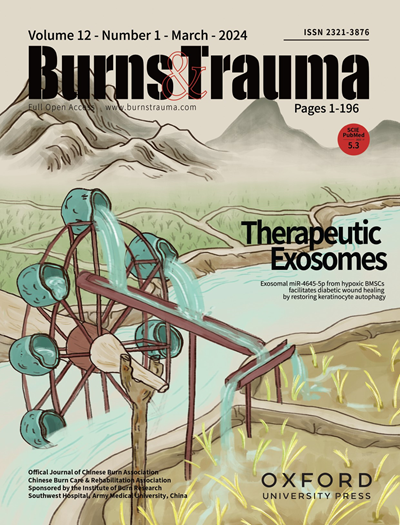Epidermal stem cell-derived exosomes improve wound healing by promoting the proliferation and migration of human skin fibroblasts
IF 9.6
1区 医学
Q1 DERMATOLOGY
引用次数: 0
Abstract
Background Epidermal stem cells (ESCs) are primarily located in the basal layer of the epidermis and play a crucial role in wound healing. ESCs-derived exosomes (ESCs-Exo) are emerging as promising candidates for skin regeneration and wound healing. However, the underlying mechanisms remain unclear. This study aims to investigate the role and mechanisms of ESCs-Exo in promoting the proliferation, migration, and collagen synthesis of human skin fibroblasts (HSFBs). Methods This study generated, isolated, and characterized ESC-Exos. The effects of ESCs-Exo on the proliferation of human skin fibroblasts (HSFBs) were detected via Cell Counting Kit-8 (CCK8), 5-Ethynyl-2'-deoxyuridine (EdU), and Proliferating Cell Nuclear Antigen (PCNA) and Marker of Proliferation Ki-67 (MKI67) gene expression methods. The effect of ESCs-Exo on the migration of HSFBs was detected via a transwell assay and a scratch test. The concentrations of collagen secreted by the HSFBs and the mRNAs of the two kinds of collagen expressed by the HSFBs were analyzed. We also analyzed the phosphorylation of Protein Kinase N1 (PKN1) and the expression of cyclins via western blotting. Finally, the effect of ESCs-Exo on wound healing was verified by animal experiments, and the key genes and signaling pathways of ESCs-Exo were excavated by transcriptomic analysis. Results Western blotting revealed that the exosomes of ESCs highly expressed established markers such as Alix, CD63, and CD9. ESC-Exos significantly promoted HSFB proliferation and migration in a dose-dependent manner, as well as HSFB collagen synthesis, and effectively increased the ratio of collagen III/I. In addition, bioinformatics analysis showed that the expression of key gene C-X-C motif chemokine ligand 9 was lower in the ESCs-Exo group, which may promote wound healing by regulating PKN1-cyclin and tumor necrosis factor signaling pathways. Animal experiments demonstrated that ESCs-Exo could reduce inflammation and accelerate wound healing. Conclusions In this study, we found that ESCs-Exo may improve wound healing by promoting the proliferation and migration of HSFBs.表皮干细胞衍生的外泌体通过促进人类皮肤成纤维细胞的增殖和迁移改善伤口愈合
表皮干细胞(ESCs)主要位于表皮的基底层,在伤口愈合中起着至关重要的作用。escs衍生的外泌体(ESCs-Exo)正在成为皮肤再生和伤口愈合的有希望的候选者。然而,潜在的机制仍不清楚。本研究旨在探讨ESCs-Exo在促进人皮肤成纤维细胞(HSFBs)增殖、迁移和胶原合成中的作用及其机制。方法本研究生成、分离和表征ESC-Exos。采用细胞计数试剂盒-8 (CCK8)、5-乙基-2′-脱氧尿苷(EdU)、增殖细胞核抗原(PCNA)和增殖标志物Ki-67 (MKI67)基因表达法检测ESCs-Exo对人皮肤成纤维细胞(HSFBs)增殖的影响。通过transwell实验和划痕实验检测ESCs-Exo对hsfb迁移的影响。分析hsfb分泌的胶原蛋白浓度及表达的两种胶原蛋白mrna。我们还通过western blotting分析了蛋白激酶N1 (PKN1)的磷酸化和细胞周期蛋白的表达。最后,通过动物实验验证了ESCs-Exo对伤口愈合的作用,并通过转录组学分析挖掘了ESCs-Exo的关键基因和信号通路。结果Western blotting结果显示,ESCs外泌体高度表达Alix、CD63和CD9等标志物。ESC-Exos以剂量依赖性的方式显著促进HSFB的增殖和迁移,促进HSFB胶原合成,并有效提高III/I型胶原的比例。此外,生物信息学分析显示,关键基因C-X-C基序趋化因子配体9在ESCs-Exo组中表达较低,可能通过调节PKN1-cyclin和肿瘤坏死因子信号通路促进创面愈合。动物实验表明,ESCs-Exo能减轻炎症,加速伤口愈合。结论在本研究中,我们发现ESCs-Exo可能通过促进hsfb的增殖和迁移来改善伤口愈合。
本文章由计算机程序翻译,如有差异,请以英文原文为准。
求助全文
约1分钟内获得全文
求助全文
来源期刊

Burns & Trauma
医学-皮肤病学
CiteScore
8.40
自引率
9.40%
发文量
186
审稿时长
6 weeks
期刊介绍:
The first open access journal in the field of burns and trauma injury in the Asia-Pacific region, Burns & Trauma publishes the latest developments in basic, clinical and translational research in the field. With a special focus on prevention, clinical treatment and basic research, the journal welcomes submissions in various aspects of biomaterials, tissue engineering, stem cells, critical care, immunobiology, skin transplantation, and the prevention and regeneration of burns and trauma injuries. With an expert Editorial Board and a team of dedicated scientific editors, the journal enjoys a large readership and is supported by Southwest Hospital, which covers authors'' article processing charges.
 求助内容:
求助内容: 应助结果提醒方式:
应助结果提醒方式:


